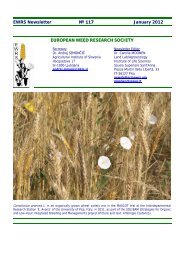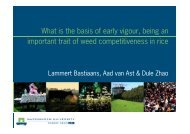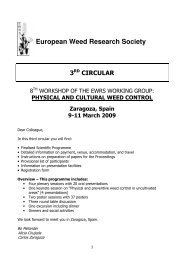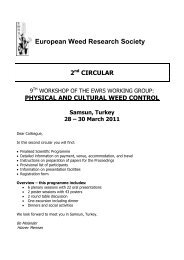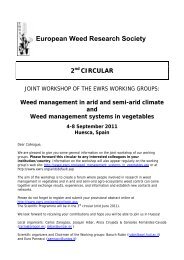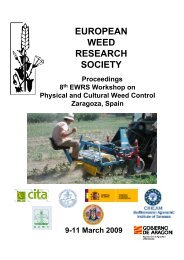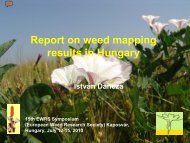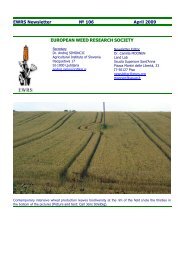Physical and Cultural Weed Control Working Group of - European ...
Physical and Cultural Weed Control Working Group of - European ...
Physical and Cultural Weed Control Working Group of - European ...
You also want an ePaper? Increase the reach of your titles
YUMPU automatically turns print PDFs into web optimized ePapers that Google loves.
9 th EWRS Workshop on <strong>Physical</strong> <strong>and</strong> <strong>Cultural</strong> <strong>Weed</strong> <strong>Control</strong> 45<br />
Samsun, Turkey, 28 – 30 March 2011<br />
All cover crops established well <strong>and</strong> L. perenne biomass was the greatest in both years (Fig. 1).<br />
In 2009, L. perenne, V. villosa, M. sativa, O. sativa, B. napus <strong>and</strong> B. rapa produced 2.812, 2.345,<br />
2.143, 2.435, 2.450 <strong>and</strong> 2.158 kg ha -1 biomass, respectively. Similar results were obtained in 2010<br />
about biomass production. When compared with the bare soil system, the cover crops reduced weed<br />
density, number <strong>of</strong> weed species that emerged, <strong>and</strong> total weed dry biomass. All cover crop<br />
treatments resulted in a decrease in the number <strong>of</strong> weed species compared to the bareground. The<br />
number <strong>of</strong> weed species was lowest at 14 DAI then increased at 28 <strong>and</strong> 56 DAI. Residues from the<br />
cover crops suppressed Urtica urens L., Convolvulus arvensis L., Chenopodium album L., Lapsana<br />
communis L., <strong>and</strong> Poa annua L. <strong>Weed</strong> dry biomass was significantly reduced in the cover crop<br />
treatments at 14 days after desiccation. Our findings indicated that cover crops suppressed many<br />
weed species in hazelnut orchard during early summer, but should not be used as the only weed<br />
control method.<br />
References<br />
Mennan, H., M. Ngouajio, D. Isık, <strong>and</strong> E. Kaya. 2006. Effects <strong>of</strong> alternative management systems on weed populations<br />
in hazelnut (Corylus avellana L.). Crop Prot. 25:835–841.<br />
Ngouajio, M., Jr, M. E. McGiffen, <strong>and</strong> C. M. Hutchinson. 2003. Effect <strong>of</strong> cover crop <strong>and</strong> management system on weed<br />
populations in lettuce. Crop Prot. 22:57–64.<br />
Ngouajio, M. <strong>and</strong> H. Mennan. 2005. <strong>Weed</strong> populations <strong>and</strong> pickling cucumber (Cucumis sativus) yield under summer<br />
<strong>and</strong> winter cover crop systems. Crop Prot. 6:521–526.<br />
Putnam, A. R., J. DeFrank, <strong>and</strong> J. P. Barnes. 1983. Exploitation <strong>of</strong> allelopathy for weed control in annual <strong>and</strong> perennial<br />
cropping systems. J. Chem. Ecol. 9:1001–1010.<br />
Reddy, K. N. 2003. Impact <strong>of</strong> rye cover crop <strong>and</strong> herbicides on weeds, yield, <strong>and</strong> net return in narrow-row transgenic<br />
<strong>and</strong> conventional soybean (Glycina max). <strong>Weed</strong> Technol. 17:28–35.



